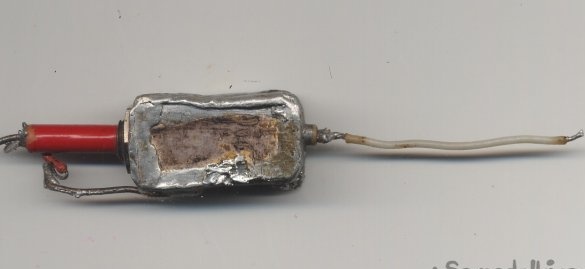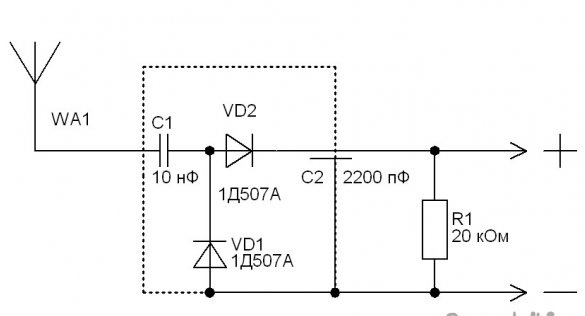I want to talk about one of my homemade. I made it twenty years ago and still use it.
It is needed when setting up receivers, transmitters, radio stations, televisions, radio microphones, and other devices where high-frequency oscillations are used.
I did not always have a high-frequency voltmeter on hand. I decided the Ts20 avometer is adaptable for this purpose. And he made a high-frequency prefix to it.
As a basis, I took the detector circuit with voltage doubling.
There was a very important question, which diodes to put there. Looked in reference books.
I understood that diodes must be high frequency, with small capacitance and germanium, in order to detect weak signals.
I checked the work of a lot of diodes. It was D2, D9, D10 and others. They worked, but up to fifty megahertz frequencies. And then I found the military-industrial 1D507A. Germanium, pulse, low-signal. They were also used in civilian equipment, called GD507A, with a capacity of 0.8 pF. Operating frequency not indicated.
I had a military-industrial generator. I gave him a 500 MHz signal. Got excellent detection.
Now I’ll tell you in detail how this prefix is arranged.
Consider a circuit diagram.
The signal from the WA1 antenna, the role of which is played by a small piece of wire, 50 mm long, enters the housing through the bushing. I soldered the case from silver-plated brass.
Through the isolation capacitor C1, the signal is fed to the detector with voltage doubling.
The rectified signal through the feed-through capacitor C2 is output from the housing and is measured by the Ts20 avometer, included in the measurement of direct voltage. Later I began to use a digital multimeter.
On the output, I added a load in the form of a resistor R1.
At one time I made low-power transmitters for television centers. Connecting the oscilloscope to the output of the console, I watched the demodulated video signal, its shape. This helped in setting up the transmitter.
The prefix provides two types of work - contact and non-contact.
Sometimes it’s enough to bring the prefix antenna to the circuit of the instrument under study. And sometimes, when the signal is low-power, you need to touch the antenna circuit.
Despite the absence of amplification cascades and a power source in the console, its sensitivity turned out to be very high. At a distance of 15 cm takes the receiver local oscillator.
The prefix is broadband, frequency range up to 500 MHz minimum.
In addition to diodes 1D507A, good results were obtained with diodes GD507A, 1D508A, GD508A and D312.
I hope you find this article useful.
Sincerely, author.


